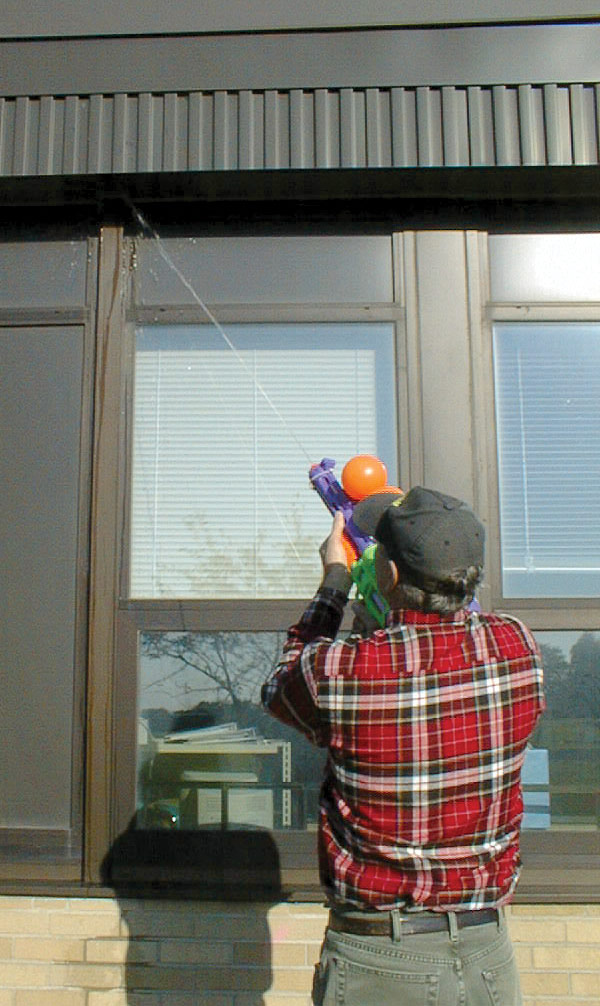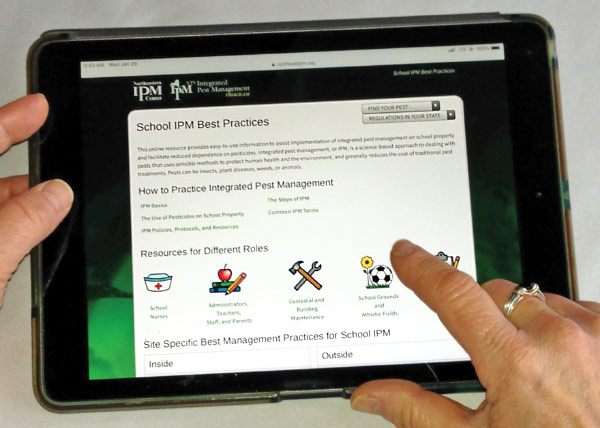Center Supports Ongoing Development of School IPM Web Resources
 |
|
Removing an early season wasp nest with a stream of water. Photo provided. |
By Lynn Braband, community IPM educator, New York State IPM Program
Pest management in schools has deservedly become an area of focus, not only in the Northeast, but also nationwide.
Reducing pesticide exposure is important for children who, by virtue of their size and developmental stage, are at greater risk of negative effects than adults.
Reducing pesticide exposure is important for children who, by virtue of their size and developmental stage, are at greater risk of negative effects than adults.
At the same time, pests can be an equally significant health hazard to staff, students, and visitors. Schools are especially challenging to manage because they include such varied and heavily used settings as classrooms, cafeterias, laboratories, auditoriums, theaters, playing fields, playgrounds, and gardens.
Pioneering School IPM Web Resources
The Northeast School IPM Working Group (NESIWG) received a Northeastern IPM Center Partnership Grant in 2013 to develop a set of best-management practices (BMPs) for safe, effective school IPM, and to build a new website to host them and make them widely available. Focus groups and training workshops were organized in three northeastern states to assess needs, and to create and collect accessible and comprehensive, yet succinct, resources.
Housed on the Northeastern IPM Center’s website, the BMP site sees considerable use and commendation from visitors who recognize its value. Even so, NESIWG members and their stakeholders recognized that keeping the site current and up to date would be an ongoing effort.
Five Years On: Time for an Update
 |
|
School IPM Best Practices website shown on a tablet computer. Photo by J. Engel. |
Given that the science behind IPM is always evolving and the web is such a dynamic medium, by 2018, NESIWG members were revisiting the site with an eye towards updating the BMPs with new information and refreshing the design to keep it relevant and usable to its audience. They also saw an opportunity to identify and populate gaps within the content by, for example, developing expanded resources on bed bugs, ticks, brown marmorated stink bugs, and vertebrates.
Gathering stakeholders’ perspectives, the NESIWG worked with Kevin Judd, Center web administrator and designer, to upgrade the website. Those efforts yielded key accomplishments, such as highlighting a school nurse outreach project, reorganizing and expanding the species fact sheets, and revising major sections of the site.
The goal was not to replace the site, but rather to update and improve its content. However, since NESIWG members were unable to devote substantial time and energy to this, progress was slow.
Renewed Financial Support
Eager to expedite the process, the working group applied for and received a 2019 communications Partnership Grant from the Center. Throughout the year, they systematically worked with Judd and David Lane, Center evaluation specialist, as well as stakeholders in four northeastern states.
Results of these efforts included:
- Reorganization of the pest species list
- Additional information on relevant pesticide use regulations in all northeastern states
- Grouping of resources by stakeholder roles
- The addition of two new pages: “Breakfast in the Classroom” and “Playgrounds”
Eager to expedite upgrades to the school IPM website, the working group applied for and received a second Partnership Grant from the Northeastern IPM Center.
Additionally, the grant objectives included updating the working group’s homepage and performing a new ranking of regional school IPM priorities, last done in 2012.
Much of the homepage’s original content consisted of links to an array of outside school IPM resources. Now, it focuses on projects solely associated with the NESIWG, also featuring a current list of group members and a much-needed index of key school IPM contacts in the Northeast.
Promotion and Future Plans
With the current changes to the site soon to be complete, the NESIWG welcomes new and returning site visitors and assistance in sharing this helpful resource, since getting the word out is a key factor in the success of this site—and of increased and effective implementation of IPM in schools.
As the group continues its work in 2020, watch for a shareable online brochure and significant use of social media targeted at school IPM stakeholder organizations throughout the Northeast and beyond.
The NESIWG and the Northeastern IPM Center are pleased to offer this outstanding resource, a collaborative undertaking and case study in combining the right tools and grant support with diverse expertise to serve a clear public need.
Visit the school IPM BMP website at: www.northeastipm.org/schools/
The Northeastern IPM Center promotes integrated pest management for reducing risks to human health and the environment. If republishing our news, please acknowledge the source (“From Northeast IPM Insights”) along with a link to our website.
